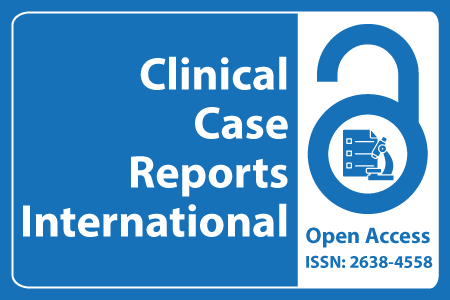
Journal Basic Info
- Impact Factor: 0.285**
- H-Index: 6
- ISSN: 2638-4558
- DOI: 10.25107/2638-4558
Major Scope
- Transplantation Medicine
- Urology Cases
- Palliative Care
- Nursing
- Psychiatry
- Child Birth
- Emergency Medicine and Critical Care
- Epilepsy and Seizures
Abstract
Citation: Clin Case Rep Int. 2020;4(1):1181.DOI: 10.25107/2638-4558.1181
Muscle Weakness Acquired in the Intensive Care Unit: Case Report
Gustavo Piech Ricardo, Lohana Santana Almeida da Silva, Marina Trombin Marques, Berenice Cataldo Oliveira Valerio, Nilza Maria Scalissi, José Viana Lima Junior, Francisco Tomaz Meneses de Oliveira and João Eduardo Nunes Salles
1Department of Endocrinology and Metabolism, Irmandade da Santa Casa de Misericórdia de São Paulo, Brazil
2Department of Neurology, Irmandade da Santa Casa de Misericórdia de São Paulo, Brazil
*Correspondance to: Gustavo Piech Ricardo
PDF Full Text Case Report | Open Access
Abstract:
Introduction: Intensive Care Unit-Acquired Weakness (ICUAW) is a growing problem, associated with a longer duration of mechanical ventilation, greater permanence and in-hospital mortality. Preventing its risk factors, therefore, becomes fundamental in the approach to the critical patient.
Case Presentation: A 45 year-old male, with no known previous comorbidities, but acromegalic phenotype, presented pale, dehydrated, hypotense and tachycardic with consciousness fluctuations to the emergency service. Investigation pointed to Diabetic Ketoacidosis (DKA) and hypokalemia. The patient underwent neuroimaging studies and Magnetic Resonance (MRI) showed a pituitary macroadenoma with suprasellar invasion. Growth Hormone (GH) and IGF-1 (Insulin Growth Factor-1) levels were increased and diagnosis of acromegaly was then established. In the fifth day there was a peak of Creatine Kinase (CK) with progressive decrease. After 12 days of hospitalization, with resistant hyperglycemia, proximal flaccid tetra paresis and global hyporeflexia (MRC score of 40 points) was noted. Clinical diagnosis of Critical Illness Myopathy (CIM) was established. After 30 days of hospitalization, he was discharged with MRC score of 50 points and improves in CK levels.
Discussion: The presented case shows a CIM, a type of ICUAW. Some important risk factors are endocrine logical (thyroid diseases, diabetes, adrenal and pituitary dysfunctions). The patient presented hyperglycemia and underwent a prolonged period of hospitalization and use
of glucocorticoid medications, increasing the risk of the disease. With clinical management and physiotherapy the patient regained autonomy.
Conclusion: ICUAW can bring long-term consequences, so that early identification and management as well as preventive measures are primordial to minimize chronic disability and morbidity.
Keywords:
Cite the Article:
Ricardo GP, Almeida da Silva LS, Marques MT, Oliveira Valerio BC, Scalissi NM, Lima Junior JV, et al. Muscle Weakness Acquired in the Intensive Care Unit: Case Report. Clin Case Rep Int. 2020;4:1181..













